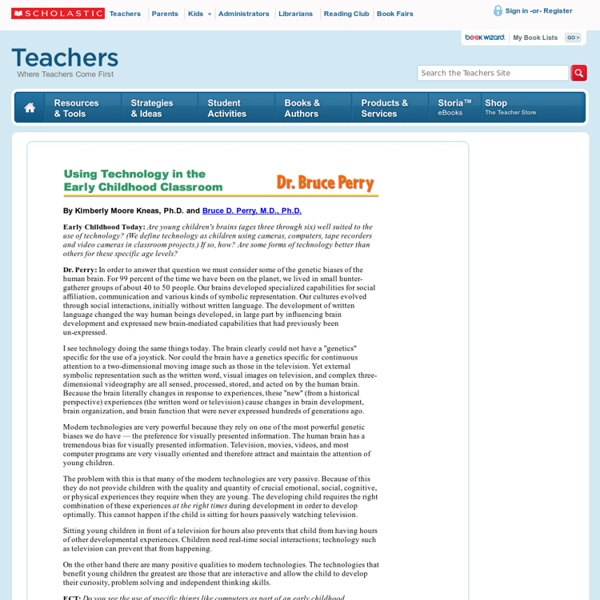Earlychildhood NEWS - Article Reading Center
We are always looking for the magic bullet, something that will solve all our problems. And, today this magic bullet for education is technology. It will solve all our problems! It will increase academic skills, reduce dropout rates, eliminate the racial divide in academic performance, and increase SAT scores. And it will make the lives of teachers easier. Well, it may not accomplish all of these goals, but educational technology does have a place in early childhood.
Using Technology to Differentiate Instruction
Resources >> Browse Articles >> Utilizing Technology Featured Author: Mrs.
www.project2061.org/publications/earlychild/online/perspect/johnson.htm
Dialogue on Early Childhood Science, Mathematics, and Technology Education Perspectives Early Childhood Education in Science, Mathematics, and Technology: An NSTA Perspective Fred Johnson
4 Benefits of having mobile technology in the classroom
If you’ve been thinking about bringing mobile technology in the classroom, my advice to you is to do it! More k-12 and higher education institutions are participating in the “mobile revolution” than ever. There are so many benefits your students are missing out on if you don’t.
Nature, Nurture and Early Brain Development
This guide is also available in Portable Document Format. Click the PDF button to the left to get it Sara Gable, State Extension Specialist, Human Development Melissa Hunting, Undergraduate Intern, Human Development For some time, we have known that development results from the dynamic interplay of nature and nurture.
Use of Technology in Teaching and Learning
Technology ushers in fundamental structural changes that can be integral to achieving significant improvements in productivity. Used to support both teaching and learning, technology infuses classrooms with digital learning tools, such as computers and hand held devices; expands course offerings, experiences, and learning materials; supports learning 24 hours a day, 7 days a week; builds 21st century skills; increases student engagement and motivation; and accelerates learning. Technology also has the power to transform teaching by ushering in a new model of connected teaching.
Advanced Brain Technologies views the brain as being malleable and plastic.
All material protected under copyright law and US. Trademark. Some exciting recent research is beginning to uncover the biochemical and genetic changes found in ADHD and brain dysfunction:
Inclusion in the 21st-century classroom: Differentiating with technology - Reaching every learner: Differentiating instruction in theory and practice
In this video, students in a gifted classroom use the multi-user learning environment Quest Atlantis to explore issues related to the creation of a game reserve in Tanzania. Interviews with the teacher and students offer perspectives on the value of using virtual worlds in the classroom . About the videoDownload video (Right-click or option-click) The diversity of the 21st-century classroom creates numerous challenges for teachers who may not have known the same diversity themselves as students. Among these, teachers must balance the requirements of high-stakes accountability while meeting the needs of diverse students within their classroom.
A Summit on Early Childhood Cognitive Development (April 30, 2002)
Susan Landry Today I will describe how researchers and educational training staff from the Center for Improving the Readiness of Children for Learning and Education (CIRCLE), University of Texas-Houston Health Science Center, have been involved in the implementation and evaluation of a model of professional development for Head Start teachers. CIRCLE's research and training efforts have been supported with over 15 years of federal, state, and private funding on issues related to understanding the factors that are most important for supporting young children's cognitive and social development.
Technology Tools
Education World offers new technology content every day. Some of our pieces related to technology tools can be found in this archive. We do update these aritcles reguarly, but given the changing nature of technology, we cannot promse that every piece will be on the cutting edge. Please visit our technology front page for the latest, most up-to-date tech stories. Social Media in the Classroom? In this information age, we can now talk to each other in ways we never imagined.



